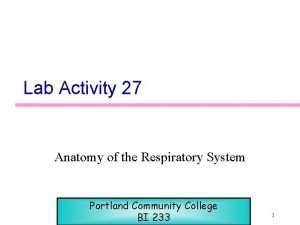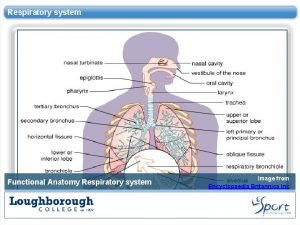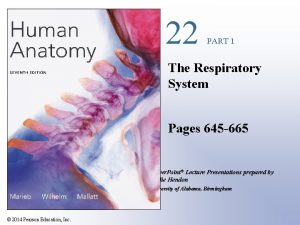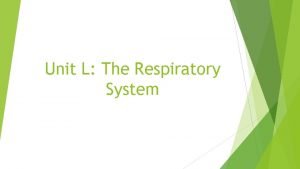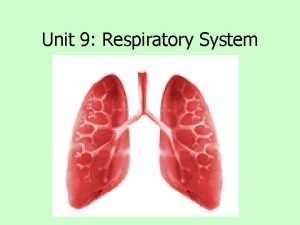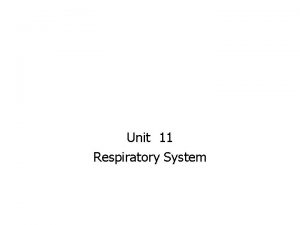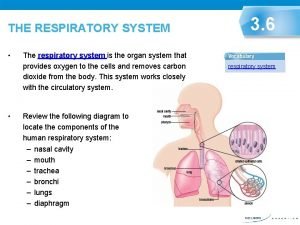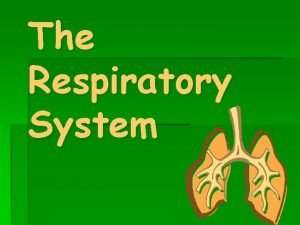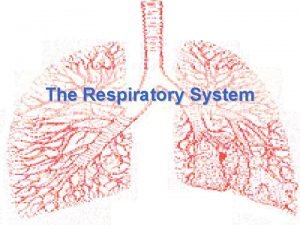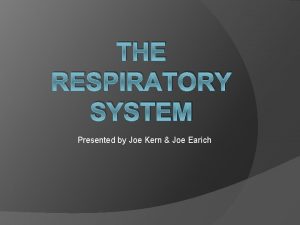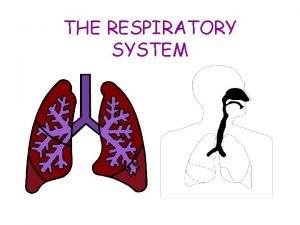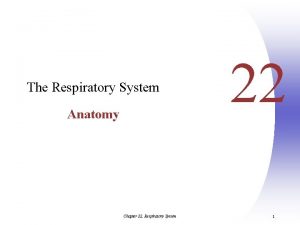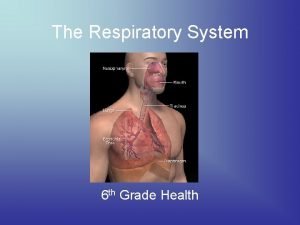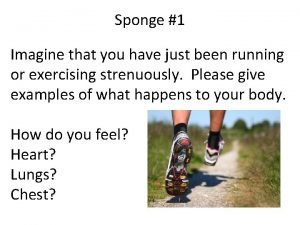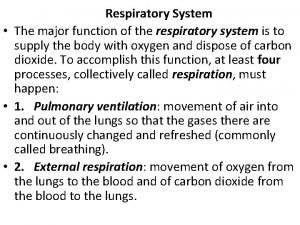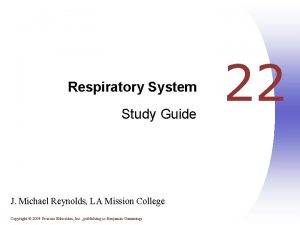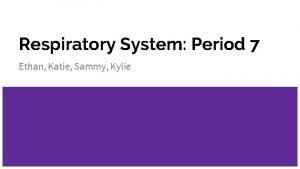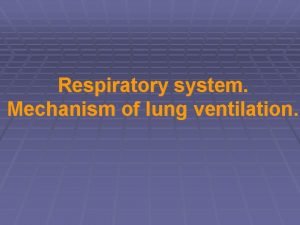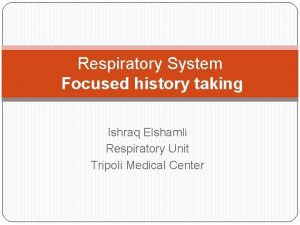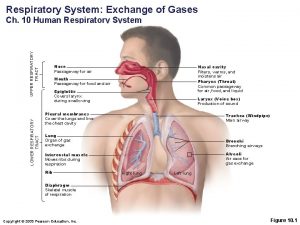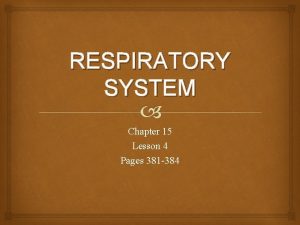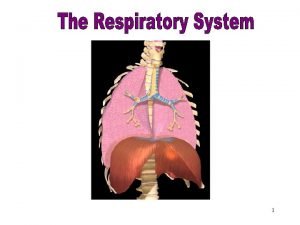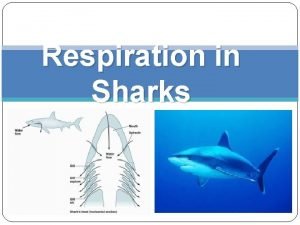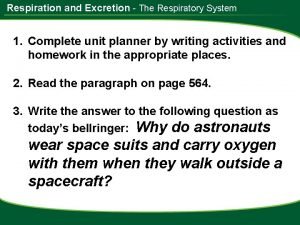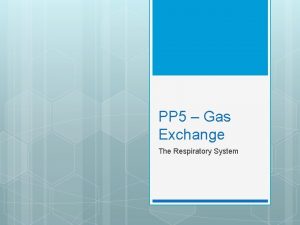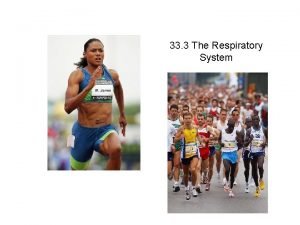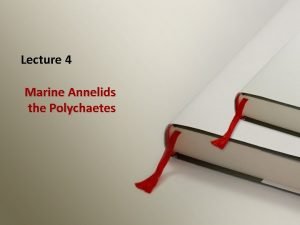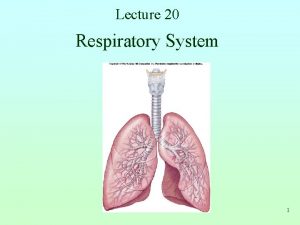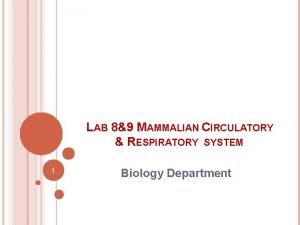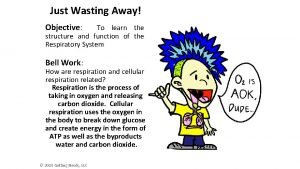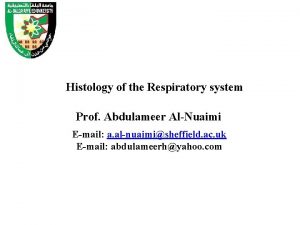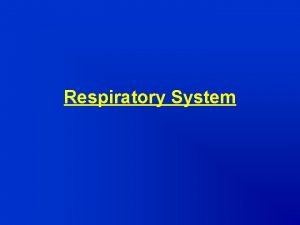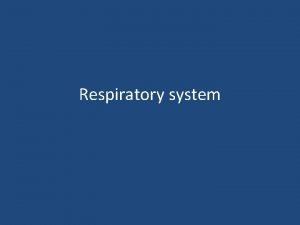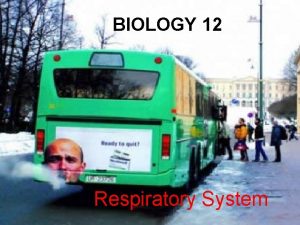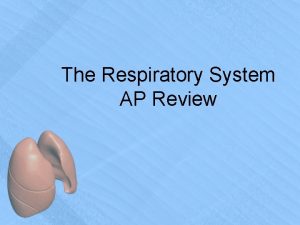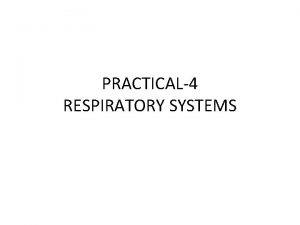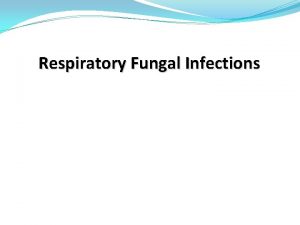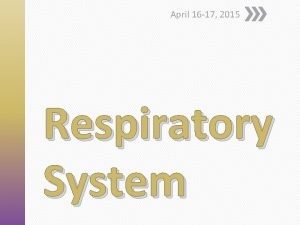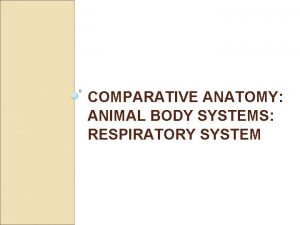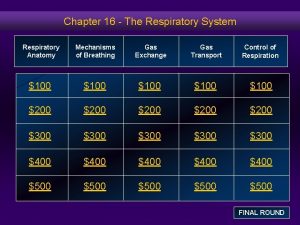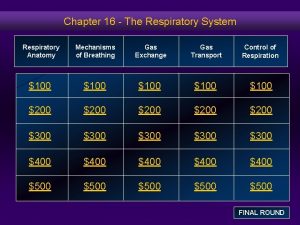The Respiratory System II Anatomy 1 The Plan











































- Slides: 43

The Respiratory System: II Anatomy 1

The Plan • Introduction – general concepts • Anatomy • Mechanics – moving air into the lungs – Structures, pressure changes • Gas Exchange – moving air from the lungs to blood and tissues – Moving O 2 in and CO 2 out of tissues • Control mechanisms – Local – CNS 2

Readings - Respiratory • Mc. Kinley, O’Loughlin, and Bidle, Anatomy and Physiology An integrative Approach, p 883 -931. • Lower Respiratory system 890 -899 • Gross anatomy 900 -906 3

Objectives • Describe the gross anatomical and histological features of the branching structures that form the lungs. • Understand the blood supply associated with the lungs. • Describe the structures that form alveoli including the cellular and acellular components involved in the blood – air barrier. 4

Organization of the Respiratory System 5

The Lungsn • The Lungs – Left and right lungs • Are in the thoracic cavity, each surrounded by a pleural cavity – They are protected by • The rib cage and the intercostal muscles • Inferiorly each lung rests on superior surface of diaphragm – Lobes of the lungs • Lungs have lobes separated by deep fissures

The Lungs • The Pleural Cavities and Pleural Membranes – Two pleural cavities • Are separated by the mediastinum – Each pleural cavity • Surrounds a lung and contains a small amount of fluid • The cavity is bordered by a mesothelial layer that form the viscera. I and parietal layers. 7

Gross Anatomical Image of the Lungs Apex The right lung has three lobes: Superior, middle, and inferior Separated by horizontal and oblique fissures Cardiac notch (a) Lateral views Right lung The left lung has two lobes: Superior and inferior Separated by an oblique fissure Left lung Main bronchus Pulmonary artery Hilum Pulmonary veins Base Right lung Left lung (b) Medial views 8

Hilum of the lung Pulmonary ARTERY Pulmonary VEIN BRONCHUS (see cartilage plates) 9

Respiratory System • Structures and Functions of the System hilum – Conducting portion = tubes only (no alveoli) • mouth/nose to terminal bronchioles • series of dichotomous, asymmetric branches • directed passage & conditioning of air – Respiratory portion • Respiratory bronchioles = tubes and alveoli • alveolar ducts, sacs, atria • alveoli only • gas exchange occurs through alveolar walls 10

Tubes only Terminal to Respiratory Bronchioles Many branches here 16 Alveoli only 11

trachea 10 bronchus Lobar Lungs: Conducting System, plastic cast 12

Bronchi to bronchioles • Bronchoscopy video – http: //www. youtube. com/watch? v=HHNme. We. Jts&NR=1 • Cancer video – http: //www. youtube. com/watch? v=tkm. ENd. A 5 o 3 g&feature=related – http: //www. youtube. com/watch? v=esj. I 3 jz. XO 7 Y&feature=related 13

Respiratory tract – conducting into respiratory portion • Function of the System – Gas exchange: O 2 in and CO 2 out • General principles – as one moves down into the branches: – epithelium changes from respiratory to cuboidal to simple squamous epithelium – the number of mucous cells and seromucous glands (hence secretions) decreases – cilia are eventually lost (not present in alveoli) – macrophages exist in the alveolar air space – branches from the pulmonary artery run parallel to the 14 bronchiolar tree and to the alveoli

Respiratory portion: General aspects Branch of pulmonary artery Bronchiole Terminal bronchiole Pulmonary arteriole Pulmonary capillary beds Pulmonary venule Branch of pulmonary vein Respiratory bronchiole Alveolar duct Alveoli Alveolar pores Interalveolar septum Alveolar sac Elastic fibers Connective tissue (a)

Respiratory portion: accent on the lung structures. Bronchiole Spiral smooth muscle Terminal bronchiole Pulmonary arteriole Pulmonary capillary beds Pulmonary venule Branch of pulmonary vein Respiratory bronchiole Alveolar duct Alveoli Alveolar pores Interalveolar septum Alveolar sac Elastic fibers Connective tissue (a)

The Respiratory tract: Bronchioles • The Bronchioles – Each tertiary bronchus branches into multiple bronchioles (branches ~4 -17) – Bronchioles finally branch into terminal bronchioles • One tertiary bronchus forms about 6500 terminal bronchioles • Bronchiole Structure – Bronchioles • Have no cartilage • Are dominated by smooth muscle – control lumen diameter 17

Nervous system controls in the Lungs • Autonomic Control – Regulates smooth muscle which • regulates diameter of bronchioles and • controls airflow and resistance in lungs • Bronchodilation (norepi/Beta 2 receptors) – dilates of bronchial airways – caused by sympathetic ANS activation – (muscles relax) - Reduces resistance • Bronchoconstriction (Ac. H/muscarinic) – constricts bronchi – caused by • Parasympathetic ANS activation (muscles constrict) • Histamine release (allergic reactions) 18

Respiratory portion: accent on the vasculature Branch of pulmonary artery Bronchiole Terminal bronchiole Pulmonary arteriole Branch of pulmonary vein Pulmonary capillary Pulmonary beds venule Respiratory bronchiole Alveolar duct Alveoli Alveolar pores Interalveolar septum Alveolar sac Elastic fibers Connective tissue (a)

4. Bronchial vein 3. Bronchial artery – only to the branches 1. Pulmonary artery (deoxygenated) – from the right ventricle 2. Branch of Pulmonary vein (oxygenated) – to the left atrium Smooth muscle around bronchioles Alveoli = Blood-Air Barrier 20

Blood supply to/from the Lungs • #1. Pulmonary artery (deoxygenated blood) • from the right ventricle (from the rt. atrium) • follows the bronchial tree all the way to the alveoli • gas exchange occurs with the alveolar capillaries • #2 Pulmonary veins -- after oxygenation, blood exits • into the left atrium … left ventricle … aorta • #3 Bronchial arteries (oxygenated blood) • from branches off the aorta • provides oxygen and nutrients to tissues of conducting passageways of lung, CT & pleura • stop before the alveoli - goes to … • #4 Bronchial veins (deoxygenated/venous blood (used by the lungs) flows • back into the right atrium or • into pulmonary veins 21

w e i v Re Blood supply for the lungs Copyright © The Mc. Graw-Hill Companies, Inc. Permission required for reproduction or display. Aorta Pulmonary trunk Pulmonary arteries Pulmonary veins Left atrium Right ventricle Left ventricle Branch of pulmonary artery Branch of pulmonary vein Pulmonary arteriole Pulmonary venule Pulmonary capillaries Alveoli Pulmonary arteries carry deoxygenated blood away from the right ventricle in the heart to the lungs. Pulmonary veins carry oxygenated blood from the lungs to the left atrium in the heart

The Lungs • Why is the proximity of the bronchiole and pulmonary artery important? • Development: helps blood vessels ‘find’ the alveoli • Coordination of air flow and blood flow • If bronchiolar air flow is blocked (mucus or tumor) blood vessels constrict to shunt blood flow to other areas of the lung with more O 2 23

Lung Pathologies • Asthma – Excessive stimulation of smooth muscle cells leads to bronchoconstriction – narrowing the bronchioles and increasing resistance – Stimulation severely restricts airflow • COPD (chronic obstructive pulmonary disease) – Chronic bronchitis – inflammation of the airways leads to narrowing of the air passageways – Emphysema – loss of alveolar walls creates fewer areas for gas exchange • Fibrosis – increased CT = difficulty expanding/contracting • Many respiratory diseases lead to SOB. (shortness of breath) 24

Lung - Emphysema B Normal Lung B 25

Diffuse Interstitial Fibrosis Normal Lung 26

muscle, elastic fibers and capillaries associated with bronchioles and alveoli Alveolar Organization: Basic Structure of a Portion of Single Lobule. 27 Copyright 2009 Pearson Education Inc. publishing as Pearson Benjamin Cummings

Respiratory portion – fine aspects • Function of the System – Gas exchange - O 2 in and CO 2 out • Cells involved – thin, delicate membranes optimized for gas exchange – type I pneumocytes and endothelial cells = WALL – fused basal laminae within the wall – type II pneumocytes secrete surfactant – connective tissue within the wall gas exchange 28

Gross – histological appearance 29

respiratory bronchiole A Alveolar duct Terminal bronchiole respiratory bronchiole Terminal bronchiole - all cuboidal cells, last branch of the conducting portion Respiratory bronchioles - contain cuboidal cells interrupted by alveoli (type I pneumocytes Alveolar ducts – all alveoli Alveoli – thin and thick areas 30

The Lungs • An Alveolus – Respiratory bronchioles are connected to alveolar ducts and both contain alveoli – Alveolar ducts end at alveolar sacs • Common chambers connected to many individual alveoli – Has an extensive network of capillaries – Is partially surrounded by elastic fibers – no smooth muscle or cartilage 31

RBCs Air space RBCs Air 32

Alveoli - thin and thick areas • Alveolar Epithelia – Consist of simple squamous epithelium • thin, delicate type I pneumocytes and • short, fat type II pneumocytes (septal cells) that produce surfactant – *Thin areas are adjacent to capillaries & active in gas exchange – Thick areas have more CT (connective tissue) – Patrolled by alveolar macrophages, also called dust cells = macrophages in the air space Thin areas are where gas exchange is optimal 33

Alveoli – thin and thick regions Thin regions contain capillaries positioned close to type I pneumocytes. Gas exchange occurs here Thick regions contain connective tissue between the capillaries and alveolar wall Interalveolar septum Erythrocyte Nucleus of capillary endothelial cell Nucleus of alveolar Erythrocyte type I cell Pulmonary capillaries Air space Alveolar type I cell Diffusion of CO 2 Alveolar type II cell Alveolar macrophages Alveolus Alveolar pores Respiratory membrane Interalveolar septum Diffusion of O 2 Alveolar epithelium Fused basement membranes of the alveolar epithelium and the capillary endothelium Air space Capillary endothelium (b) Thick region Capillary

Alveoli – thin and thick regions Type I pneumocyte Forms most of the alveolar wall 5% of cells & 95% of the surface Type II pneumocyte Produces - Surfactant - An oily secretion of phospholipids and proteins - Coats alveolar surfaces and reduces surface tension - 95% of cells & 5% of the surface Thin region Interalveolar septum Erythrocyte Nucleus of capillary endothelial cell Nucleus of alveolar Erythrocyte type I cell Pulmonary capillaries Air space Alveolar type I cell Diffusion of CO 2 Alveolar type II cell Alveolar macrophages Alveolus Alveolar pores Respiratory membrane Interalveolar septum Diffusion of O 2 Alveolar epithelium Fused basement membranes of the alveolar epithelium and the capillary endothelium Air space Capillary endothelium (b) Thick region Capillary

Alveolus air space Thin areas RBCs 36

The Blood – Air Barrier Interalveolar septum Erythrocyte Nucleus of capillary endothelial cell Nucleus of alveolar Erythrocyte type I cell Pulmonary capillaries Alveolar type I cell Diffusion of CO 2 Alveolar type II cell Diffusion of O 2 Alveolar macrophages Alveolus Alveolar pores Respiratory membrane Interalveolar septum Alveolar epithelium Fused basement membranes of the alveolar epithelium and the capillary endothelium Capillary endothelium (a) (b) Capillary

The Blood- Air Barrier (plasma) 38 Copyright 2009 Pearson Education Inc. publishing as Pearson Benjamin Cummings

Blood-Air Barrier Note 5 layers! CO 2 1. What happens if: -one adds CT to the thin area? -surfactant is not made? 2. (Type I pneumocyte) 3. Erythrocyte (Hemoglobin mol. ) 4. 5. Red blood cell membrane 39

ry a m m u S Respiratory System • Structures and Functions of the System hilum – Conducting portion = tubes only (no alveoli) • mouth/nose to terminal bronchioles • series of dichotomous, asymmetric branches • directed passage & conditioning of air – Respiratory portion • Respiratory bronchioles = tubes and alveoli • alveolar ducts, sacs, atria • alveoli only • gas exchange occurs through alveolar walls 40

Respiratory portion: General aspects Sum y r a m Branch of pulmonary artery Bronchiole Terminal bronchiole Pulmonary arteriole Pulmonary capillary beds Pulmonary venule Branch of pulmonary vein Respiratory bronchiole Alveolar duct Alveoli Alveolar pores Interalveolar septum Alveolar sac Elastic fibers Connective tissue (a)

For those who want more: • A great electron micrograph of a type II pneumocyte with a description 42

Type II Pneumocyte - produces surfactant N Myelin bodies N Correlate: respiratory distress syndrome - RDS 43
 Respiratory zone and conducting zone
Respiratory zone and conducting zone Anatomy of the respiratory system
Anatomy of the respiratory system Respiratory system
Respiratory system Respiratory system anatomy and physiology
Respiratory system anatomy and physiology Circularory system
Circularory system The upper airways
The upper airways Anatomy of the upper respiratory tract
Anatomy of the upper respiratory tract Respiratory zone
Respiratory zone Tiny air sacs at the end of the bronchioles
Tiny air sacs at the end of the bronchioles Circulatory system and respiratory system work together
Circulatory system and respiratory system work together Bozeman respiratory system
Bozeman respiratory system Unit 9 respiratory system
Unit 9 respiratory system Diagnostic test of respiratory system
Diagnostic test of respiratory system Respiratory system
Respiratory system Voice box
Voice box Respiratory system coloring page
Respiratory system coloring page Respiratory system purpose
Respiratory system purpose Conclusion about respiratory system
Conclusion about respiratory system Respiratory system jobs
Respiratory system jobs Chapter 7 cengage
Chapter 7 cengage Bronchide
Bronchide 22
22 Interesting facts about respiratory system
Interesting facts about respiratory system How to draw the respiratory system
How to draw the respiratory system What is the major function of the respiratory system
What is the major function of the respiratory system Respiratory system diagram unlabeled
Respiratory system diagram unlabeled Respiratory system vocabulary
Respiratory system vocabulary Pathway of air
Pathway of air Kylie knh
Kylie knh Respiratory zone and conducting zone
Respiratory zone and conducting zone History taking respiratory system
History taking respiratory system Upper and lower respiratory system
Upper and lower respiratory system Chapter 15 lesson 2 the respiratory system
Chapter 15 lesson 2 the respiratory system Diagnostic test of respiratory system
Diagnostic test of respiratory system Sharks respiration
Sharks respiration Flowchart of respiratory system
Flowchart of respiratory system Trachea, trachioles, alveoli
Trachea, trachioles, alveoli Arthropoda
Arthropoda Exhale respiratory system
Exhale respiratory system Polychaeta respiratory system
Polychaeta respiratory system What is the conducting zone of the respiratory system
What is the conducting zone of the respiratory system Respiratory system of rabbit
Respiratory system of rabbit The respiratory system just wasting away answer key
The respiratory system just wasting away answer key The parts of the respiratory system
The parts of the respiratory system

